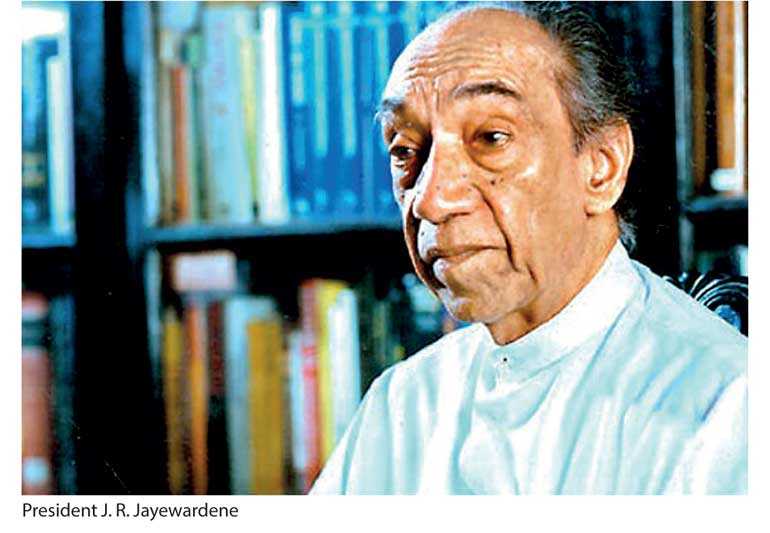Thursday Dec 11, 2025
Thursday Dec 11, 2025
Friday, 11 May 2018 00:00 - - {{hitsCtrl.values.hits}}

 After the 1977 election win, President J. R. Jayewardene brought in a new Constitution which changed the First Past the Post system in Sri Lanka to a Proportional Representation system. President J. R. Jayewardene may have known that the Proportional Representation system would also bring in results where one party may not be able to win a majority. So an Executive Presidency was established.
After the 1977 election win, President J. R. Jayewardene brought in a new Constitution which changed the First Past the Post system in Sri Lanka to a Proportional Representation system. President J. R. Jayewardene may have known that the Proportional Representation system would also bring in results where one party may not be able to win a majority. So an Executive Presidency was established.
Proportional Representation (PR) system is considered as much less stable as it creates an environment where no major party can win a majority. So the national parties will have to form a government with the support of the smaller parties. But an executive presidency is kept because sometimes parties cannot form a majority leaving the government without a proper authority, as was the example of Belgium. After the 2010 Belgium general elections, no party was able to get a majority so the coalition talks went on for 18 months before a government was formed, leaving the country ungoverned during that time.
J.R. Jayewardene brought in the new Constitution which changed the system. But why did he want to change the First Past the Post (FPP) system into the Proportional Representation (PR) system? A look at the 1970 general election results will tell the answer.
The SLFP led by Sirimavo Bandaranaike won the 1970 general elections getting 91 seats while the United National Party only won 17 seats. In 1970, the SLFP won five times more seats than the UNP. But how many votes did the SLFP and the UNP get respectively? SLFP got 36.9% of the votes and got 91 seats while the UNP got 37.9% of the votes and only got 17 seats.
Actually the UNP had more votes (and won the popular vote in 1970) than the SLFP in 1970 but the SLFP ended up with 5 times the seats the UNP got. A similar situation to how Donald Trump won the 2016 Presidential election where Trump got 304 delegates while Hillary Clinton got only 227 delegates and lost even though Hillary Clinton had three million more votes than Donald Trump. If hypothetically speaking Hillary Clinton had the power to change the Constitution of the United States to make the person who got the most votes win an election, wouldn’t Hillary Clinton do it? J.R. Jayewardene was in that situation in 1977 and he changed it knowing the UNP had a larger voter base and with the PR system, the UNP could be in power for a long time.
FPP system is considered less democratic as a party where just one third of the vote can win an outright majority as was the case in the Indian general election of 2014. The Narendra Modi-led BJP coalition only got 31.4% of the votes but had a majority of seats in parliament. It gives stable governments but not necessarily the government the majority of the people want. And the PR system is more representative of the people as seats are won more closely to the percentage of votes a party gets.
Then again, the PR system has its flaws which are unstable governments so an executive presidency is kept to keep stability. But what can happen if the PR system is kept but the executive presidency is removed? Israel is a country that can be studied as it has a proportional representation system of governance without an executive presidency. Israel has a ceremonial President. If Sri Lanka removes the executive presidency while retaining the proportional representation system, the Sri Lankan political system can become like the Israeli political system. A study of Israeli politics can show us what we could be getting ourselves into.
Israel has a PR system where the minimum votes needed for a party to send members to the Knesset is 2%. This has resulted in Israel having very fractious and unstable governments with up to 10 parties entering the Israeli parliament, the Knesset through the 2015 general elections and more than 10 parties have entered in elections before that.
The issue with the Israeli system of governance is it gives very high proportionality as Israel lacks smaller districts so the seats are allocated on a national count of votes, unlike in Sri Lanka where seats are allocated to a district in proportionality. In Israel, people do not vote directly for any candidate and have no preferential votes. Instead, a list of candidates is put out. People vote for the parties only and seats are allocated to a party according to the votes the party gets.
If a party gets 25 seats, then the first 25 candidates in the party list are members of the Knesset (MKs). The Sri Lankan system gives a slightly more stable PR system as seats are allocated according to districts and the party that has the highest votes wins a bonus seat in the district as well.
The main issue has been instability and indecisiveness with many coalitions in a parliament unable to get an outright majority. This has led to weak governments which are held captive by the smaller coalition partners. Italy is another example which can be compared as Italy too has a PR system with instability.
In the last general elections in Israel. The largest party was the Benjamin Netanyahu led Likud which won 30 seats out of the 120 seats in the Knesset. That is 25% of the seats. The second highest was by the Zionist Union which won 24 seats. And the rest of the 66 seats were taken by the remaining 8 parties. This shows that even if the two largest parties/alliances in Israel, the Likud and the Zionist Union combine, they still cannot form a government as they will only have 54 seats, which is six seats short. This leaves the main parties to negotiate with much smaller parties to form a government. A lot has to be compromised to get the support of various parties whose demands can be diverse.
The current government of Benjamin Netanyahu has six parties coming together. This has also resulted in important ministries being held by different parties. The defence ministry, the finance ministry and the education ministry are held by three different parties and all three ministers are not from the Prime Minister’s party. There is no unity in strategy. Any arguments or failure by the government to fulfil a promise to a smaller party will result in that party leaving the government and possibly cause the fall of the government if the majority is lost.
The bigger problem is extremist parties can easily enter the Knesset. Fringe parties with a vote base of less than 3% can make it to the Knesset and desperate leaders of major parties can and do give in to their demands to form governments. We see the Israeli government unable to take action against settlers as any move by the government against the settlers taking Palestinian land, means a strong reaction from the extremist parties which hold the government together. This not only makes the task of stopping settler activity harder but also makes decisions on the Palestine peace process almost impossible.
This has also resulted in smaller orthodox parties negotiating and getting money from the Israeli budget to finance their orthodox voters with welfare schemes to remain without jobs. Israeli PM Netanyahu threatens Iran and defies Israel’s main ally, the United States regarding the settlers but even he bows down to the orthodox parties on providing welfare to the vote base of the smaller parties in his coalition.
An example is the Haredim community in Israel whose men are known to not work and study religion while living on welfare. This welfare system can cause damage to the short term and long term future of Israel but the PM has no choice but to bow down to the wishes of fringe parties. This system has encouraged various parties to be formed knowing they can be kingmakers even though they get less than 3% of the votes. The system is also impossible to change as a two thirds majority is needed to change the system and no small party will want a change as it serves them well.
Can Sri Lanka’s electoral system function without
the presidency?
A debate is going in Sri Lanka to remove the executive presidency but without changing the PR system. Without the Executive Presidency to fall on in times of parties being unable to form a majority, the country can descend into chaos.
Sri Lanka has had seven general elections in the proportional representation electoral system. Only twice has a party/coalition been able to win a majority. First time was the UNP led by President Ranasinghe Premadasa in 1989, when the UNP won 125 seats. The second time was in 2010, when the UPFA led by President Mahinda Rajapaksa won 144 seats.
Both the general elections of 1989 and 2010 were held after a presidential elections where President Premadasa and President Rajapaksa respectively won it so the people voted knowing which party had won a few months earlier. The other five general elections of 1994, 2000, 2001, 2004 and the last one in 2015 did not see any party or coalition win an outright majority.
The same problems Israel is facing can come to daunt us. Minor parties can hold the government to ransom. Governments formed with the support of fringe parties will prevent any solution to Sri Lanka’s national problems being solved. The smaller parties may approve to remove the Executive Presidency but they will not allow the proportional representation system to be changed into the first past the post system as smaller parties will get wiped out under a first past the post system.
Removing the Executive presidency will make Sri Lankan elections like the ones in Israel and Italy. What if Sri Lanka abolishes the executive presidency and in a general election, no party wins a majority? Are we going to be negotiating like how the politicians in Belgium did for 18 months in 2010 after its elections brought a hung parliament?